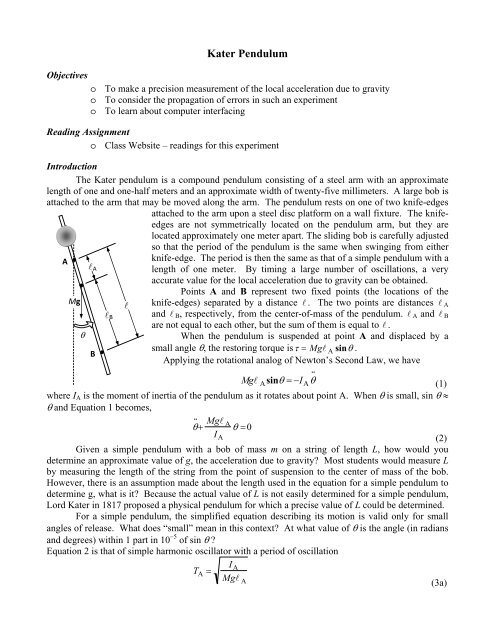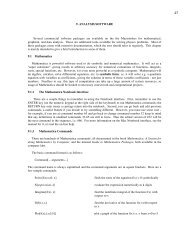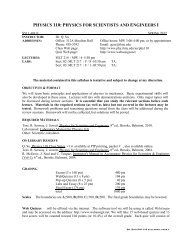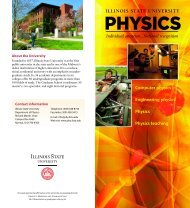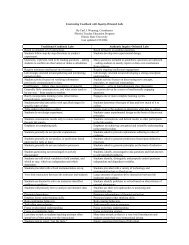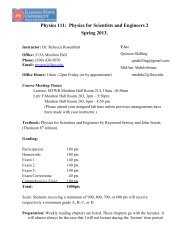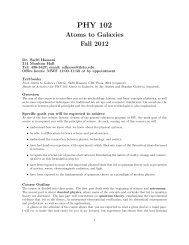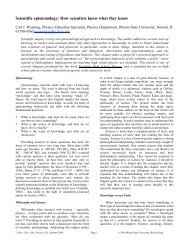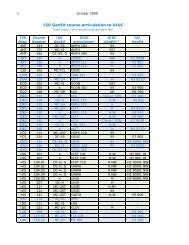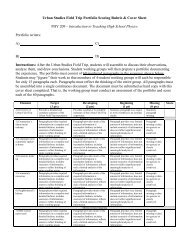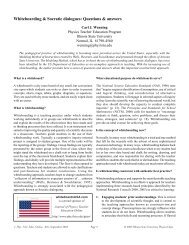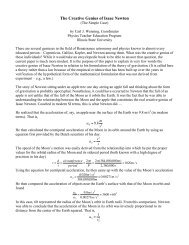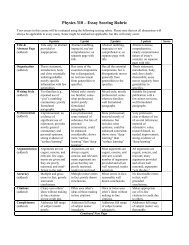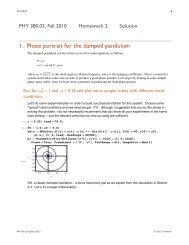Kater Pendulum
Kater Pendulum
Kater Pendulum
Create successful ePaper yourself
Turn your PDF publications into a flip-book with our unique Google optimized e-Paper software.
Objectives<br />
<strong>Kater</strong> <strong>Pendulum</strong><br />
o To make a precision measurement of the local acceleration due to gravity<br />
o To consider the propagation of errors in such an experiment<br />
o To learn about computer interfacing<br />
Reading Assignment<br />
o Class Website – readings for this experiment<br />
Introduction<br />
The <strong>Kater</strong> pendulum is a compound pendulum consisting of a steel arm with an approximate<br />
length of one and one-half meters and an approximate width of twenty-five millimeters. A large bob is<br />
attached to the arm that may be moved along the arm. The pendulum rests on one of two knife-edges<br />
attached to the arm upon a steel disc platform on a wall fixture. The knifeedges<br />
are not symmetrically located on the pendulum arm, but they are<br />
located approximately one meter apart. The sliding bob is carefully adjusted<br />
so that the period of the pendulum is the same when swinging from either<br />
A<br />
knife-edge. The period is then the same as that of a simple pendulum with a<br />
lA<br />
length of one meter. By timing a large number of oscillations, a very<br />
accurate value for the local acceleration due to gravity can be obtained.<br />
Points A and B represent two fixed points (the locations of the<br />
Mg<br />
l knife-edges) separated by a distance l . The two points are distances l A<br />
l B and l B , respectively, from the center-of-mass of the pendulum. l A and l B<br />
are not equal to each other, but the sum of them is equal to l .<br />
θ<br />
When the pendulum is suspended at point A and displaced by a<br />
small angle θ, the restoring torque is τ = Mgl A sinθ .<br />
B<br />
Applying the rotational analog of Newton’s Second Law, we have<br />
Mgl A sinθ =−I A θ<br />
(1)<br />
where I A is the moment of inertia of the pendulum as it rotates about point A. When θ is small, sin θ ≈<br />
θ and Equation 1 becomes,<br />
..<br />
θ+ Mgl A<br />
θ =0<br />
I A (2)<br />
Given a simple pendulum with a bob of mass m on a string of length L, how would you<br />
determine an approximate value of g, the acceleration due to gravity? Most students would measure L<br />
by measuring the length of the string from the point of suspension to the center of mass of the bob.<br />
However, there is an assumption made about the length used in the equation for a simple pendulum to<br />
determine g, what is it? Because the actual value of L is not easily determined for a simple pendulum,<br />
Lord <strong>Kater</strong> in 1817 proposed a physical pendulum for which a precise value of L could be determined.<br />
For a simple pendulum, the simplified equation describing its motion is valid only for small<br />
angles of release. What does “small” mean in this context? At what value of θ is the angle (in radians<br />
and degrees) within 1 part in 10 −5 of sin θ ?<br />
Equation 2 is that of simple harmonic oscillator with a period of oscillation<br />
..<br />
T A =<br />
I A<br />
Mgl A<br />
(3a)
Similarly, if the pendulum is suspended at point B, the period is given by<br />
I B<br />
T B =<br />
Mgl B<br />
(3b)<br />
By applying the parallel axis theorem, we can write<br />
2<br />
2<br />
I A = I CM + Ml A and I B = I CM + Ml B (4)<br />
where I CM is the moment of inertia of the pendulum about the center-of-mass. Then, substitute<br />
equations 4 into equations 3a and 3b and assume that the system has been arranged so that periods T A<br />
and T B are equal. With this assumption, equations 3a and 3b are set equal to each other and I CM can be<br />
determined.<br />
I CM = Ml A l B (5)<br />
Substituting this result into either equation 3a or 3b gives<br />
T = T A = T B = 2π<br />
or<br />
l A +l B<br />
g<br />
T = 2π<br />
l g<br />
(6)<br />
Our goal is to measure g to a precision in the range 10 –4 to 10 –5 . Measuring g with precision<br />
and accuracy requires that the period and the length between the two pivot points be determined with<br />
precision and accuracy. Since the standard error of the mean value, a measure of how well we know<br />
the average of multiple measurements is the true value, is given by<br />
s<br />
σ x<br />
=<br />
N<br />
(7)<br />
where s is the standard deviation and N is the number of measurements. From past experience, the<br />
deviation between successive measurements is on the order of 10 –4 , so if we want to increase our<br />
precision by a factor of ten, we must make at least 100 measurements of the period.<br />
Experimental Procedure<br />
Part A: Preparation of the <strong>Kater</strong> <strong>Pendulum</strong><br />
Familiarize yourself with the <strong>Kater</strong> pendulum and its fixture. Note: the knife edge rests on a<br />
metal platform that can be damaged by dropping the pendulum onto it. Each time the<br />
pendulum is to be replaced on the platform, the pendulum must be gently lowered onto it so as<br />
not to damage it.<br />
Note the markings on the thin side that may be used to measure the position of the bob.<br />
Position the bob so that it is at the zero position (the line closest to the knife edge). Carefully<br />
and gently return the pendulum to the wall fixture. Failure to gently set the knife edge on the<br />
platform will result in damage to the platform, which produces a very large error.
Part B: Knife-edge separation distance<br />
1. The distance between the knife edges is measured using a good precision cathetometer with<br />
a range of one meter. Set up the cathetometer and become familiar with its use.<br />
2. Each student in the group should take a turn at measuring l , the distance between the two<br />
knife-edges. Record each measurement separately and independently. When everyone has<br />
made the measurement, then each student should record the other students’ measurements.<br />
The group will then determine and average value of l to use in the calculation of g.<br />
Part C: Period timing<br />
1. A photogate is used to measure the period as the pendulum swings. Set up the photogate so<br />
that it is fixed in place at the lowest position of the pendulum swing.<br />
2. A small angle of release is required by the theory for this experiment. As a group,<br />
determine a value for the small angle that will be consistently used for all measurements<br />
during the experiment. Use the protractor provided. For all measurements, the same<br />
release position will be used. Be sure to write down the results of your group discussion on<br />
this issue in your notebook.<br />
3. The Data Studio computer program has been set up to have a 30 second delay before data is<br />
collected and stored. This is designed to minimize effects due to a wobble introduced when<br />
the pendulum is released. Very gently release the pendulum from the chosen release<br />
position, then start the Data Studio data collection for the run. The computer program has<br />
been set up to collect timing data for 240 seconds. This should allow more than 110<br />
periods to be observed.<br />
4. Move the bob to the next position and repeat step 3. Do this for 12 positions.<br />
5. Invert the pendulum and repeat steps 3 and 4.<br />
Analysis<br />
1. Export the timing data to text files as instructed.<br />
2. Load the data into an Excel spreadsheet to determine each period throughout a given run.<br />
3. Calculate the average period and its standard deviation for each run.<br />
4. Each student should independently plot the period versus bob position for each orientation<br />
of the pendulum. Do a least squares linear fit for each of the two orientations. Write down<br />
the equation for the line using the precision of our measurement on the graph. Using the<br />
two equations determined in this manner, find the intersection of the two lines. This is the<br />
equal period point. It is this value of the period that goes into our calculation for g.<br />
5. Calculate g along with a value of the fractional uncertainty σ g /g determined through error<br />
propagation analysis as discussed in class.<br />
6. Explain and illustrate the differences between a simple pendulum and the <strong>Kater</strong> pendulum,<br />
in terms of their construction and equations of motion.<br />
7. Did your results achieve the precision we set out to achieve? How can you tell? If not,<br />
why not?<br />
One way to earn additional credit is to devise additional ways to analyze the data to gain some<br />
additional information about this experiment.


